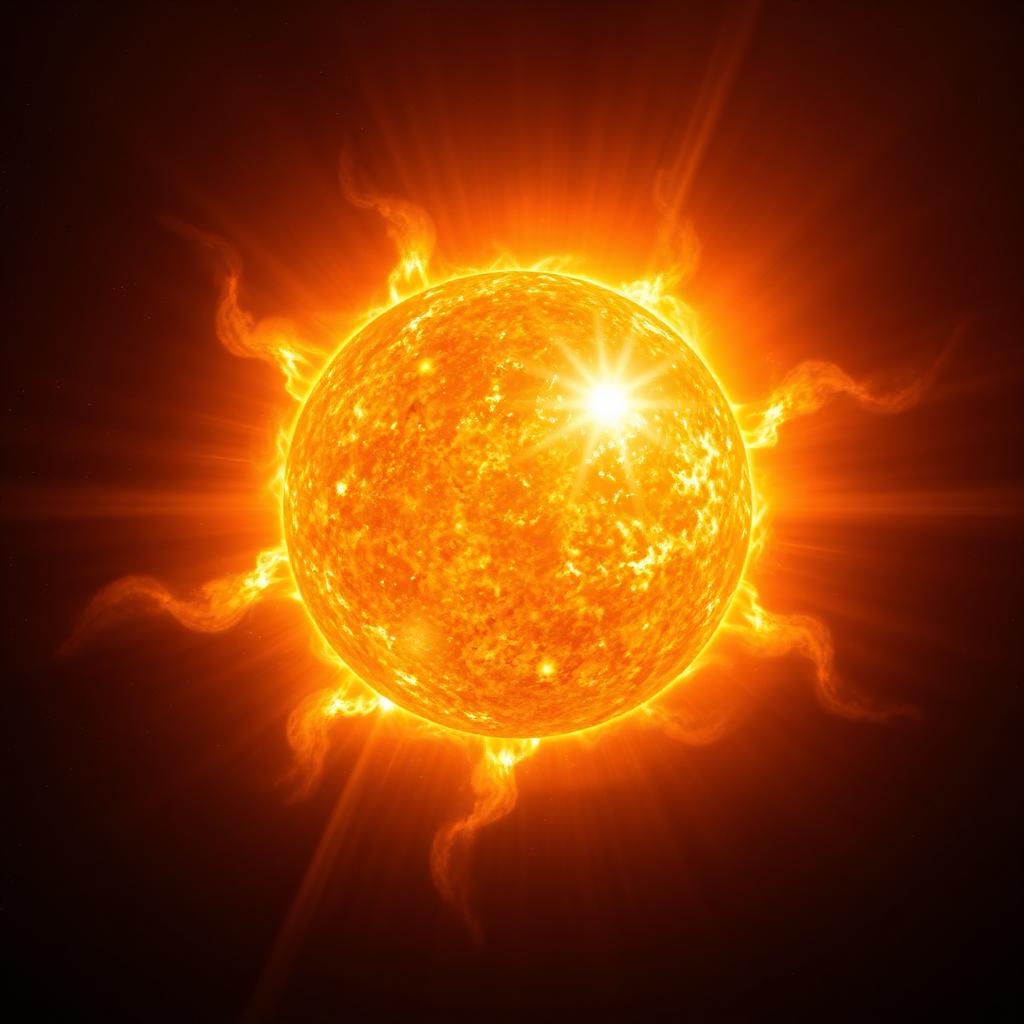⭐ 中学生にもわかりやすい表現にした説明です。
—
太陽のフレアは、太陽の表面で一瞬だけとても明るくなる現象です。これは、太陽の磁気(じょうき)といううずまきのような力が強くなることで起こります。磁気がぐちゃぐちゃになって、エネルギーがたまると、突然そのエネルギーが放出されて、太陽の明るさが一気に増えるのです。
太陽は約11年ごとに活動の多さが変わる周期(月のサイクル)を持っています。活動が少ない時期(静かな時期)と、多い時期(活発な時期)があります。最も活動が盛んな時期を「太陽の極大期」と呼びます。
2025年7月には、まさにこの太陽の活動が一番盛んな時期に近づいています。科学者たちは、2024年から2026年くらいまでがピークだと予想しており、それに合わせて太陽がとても活発になっているのです。
最近の観測や研究によると、太陽の磁気の動きが複雑になっていて、多くのフレアや爆発が起こる可能性が高まっています。これは、「磁気の線」がねじれたり絡まったりしているためで、その「絡まり」が解けるときにエネルギーが一気に放出されてフレアが起きると考えられています。
つまり、2025年の今、太陽がとても活動的なのは、ちょうどこの太陽のサイクルのピークにさしかかっているからです。これらの理解は、宇宙の研究者たちの努力のおかげでどんどん進んでおり、将来はもっと正確に予測できるようになるでしょう。
—

⭐⭐⭐⭐⭐⭐⭐⭐⭐⭐⭐⭐⭐⭐⭐⭐⭐⭐⭐
太陽フレアは、太陽の表面で発生する突然の輝度の増加で、通常は太陽黒点群の近くで起こります。この現象は、太陽の磁場がねじれてエネルギーを蓄積し、最終的に爆発的に解放されるときに発生します。
**太陽活動周期と極大期**
太陽は約11年の周期で活動を繰り返しており、これを太陽周期と呼びます。周期の中盤には極大期があり、この時期には太陽黒点数が増加し、太陽フレアやコロナ質量放出(CME)が頻発します。
**2025年の太陽活動予測**
太陽活動周期25(2019年頃始まった)は、現在極大期に向かっています。この極大期は、多くの科学者によって2024~2026年頃にピークを迎えると予測されています。したがって、2025年7月に太陽フレア活動が活発になっている理由は、主にこの周期的な極大期にあると考えられます。
**学術的背景**
近年、NASAや国際宇宙天気センターなどの研究機関が行っている観測やモデルにより、太陽の磁場活動の予測精度が向上しています。これらの研究によれば、太陽周期25は比較的活発なものになる可能性があるとされており、したがって太陽フレアの頻度や規模が大きくなることが期待されています。
**活動が活発になるメカニズム**
太陽フレアの発生は、太陽表面の磁場がどのように蓄積され、解放されるかにかっています。このプロセスは現在も研究が進められており、観測技術の進化につれて徐々に理解が深まってきています。最新のシミュレーションでは、磁場線の再接続がその鍵を握っているとされています。
総合すると、2025年7月の太陽フレア活動の活発さは、自然な太陽活動周期の結果であり、特に太陽周期25の極大期に起因しています。学術的な研究は、この活動をより詳細に予測するための重要な基盤を提供しています。
■英語に翻訳いたしました。
Certainly! Here is a translation of the explanation into high-level, Nature-quality English:
—
Solar flares are sudden, intense brightenings on the Sun’s surface, typically occurring near sunspots. These phenomena result from the sudden release of magnetic energy that has been stored through the twisting and tangling of the solar magnetic field. When this energy is abruptly liberated, a flare occurs.
The Sun operates on an approximately 11-year solar activity cycle, characterized by alternating periods of solar minimum and maximum. The solar maximum—also known as the solar maximum phase—is marked by an increase in sunspot numbers and heightened solar activity, including frequent and intense solar flares and coronal mass ejections (CMEs).
As of July 2025, the Sun is approaching its solar maximum in the ongoing Solar Cycle 25 (which began around 2019). Current scientific forecasts suggest that this cycle will reach its peak between 2024 and 2026, accounting for the heightened level of solar flares observed in mid-2025.
Recent advances in observational technology, such as those employed by NASA and the International Space Weather Center, have significantly improved our understanding and predictive capabilities of solar magnetic activity. These forecasts indicate that Cycle 25 is expected to be relatively active, correlating with the increased flare activity observed.
The mechanism driving this increased activity involves the complex interplay of the Sun’s magnetic fields. Magnetic field lines become twisted and sheared over time, storing energy that can be suddenly released through magnetic reconnection—a process whereby magnetic field lines realign and accelerate energetic particles, producing flares.
In essence, the peak in flare activity during this period is a natural consequence of the solar cycle’s progression. Ongoing research, bolstered by detailed observations and sophisticated modeling, continues to shed light on the magnetic dynamics underlying these energetic phenomena, paving the way for more accurate space weather forecasting.
—
Let me know if you’d like it further refined!


